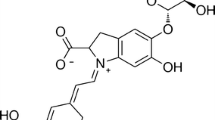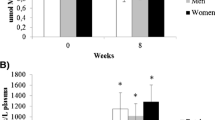Abstract
Pycnogenol® (PYC), an extract of French maritime pine bark (Pinus pinaster), is a potent antioxidant with potential health benefits. Its bioavailabilty has previously been shown by urinary excretion studies of constituents and metabolites of PYC. The aim of this study was to test the effect of PYC supplementation on measures of oxidative stress and the lipid profile in humans. Twenty-five healthy subjects received PYC (150 mg/d) for 6 wk. Fasting blood was collected at baseline, after 3 and 6 wk of supplementation, and again after a 4-wk washout period. After 6 wk of supplementation with PYC, a significant increase in plasma polyphenol levels was detectable, which was reversed after the 4-wk washout phase. The antioxidant effect of PYC was demonstrated by a significant increase in oxygen radical absorbance capacity (ORAC) in plasma throughout the supplementation period (P<0.05). The ORAC value returned to baseline after the 4-wk washout period. Moreover, in addition to its antioxidant effects, PYC significantly reduced LDL-cholesterol levels and increased HDL-cholesterol levels in plasma of two-thirds of the subjects. While the LDL changes reversed during washout, the HDL increase did not. There was no significant difference in LDL oxidizability or plasma lipid peroxides following PYC supplementation. Hence, following oral supplementation in humans, PYC significantly increases antioxidant capacity of plasma, as determined by ORAC, and exerts favorable effects on the lipid profile.
Similar content being viewed by others
Abbreviations
- AAPH:
-
2,2′-azobic(2-amidinopropane)dihydrochloride
- BMI:
-
body mass index
- CAD:
-
coronary artery disease
- CBC:
-
complete blood count
- FOX:
-
ferrous oxide-xylenol orange
- ORAC:
-
oxygen radical absorbance capacity
- β-PE:
-
β-phycoerythrin
- PYC:
-
Pycnogenol®
- ROS:
-
reactive oxygen species
- TSH:
-
thyroid-stimulating hormone
References
Witztum, J.L., and Steinberg, D. (1991) Role of Oxidized Low Density Lipoprotein in Atherogenesis, J. Clin. Invest. 88, 1785–1792.
Flohé, L., Brigelius-Flohé, R., Saliou, C., Traber, M., and Packer, L. (1997) Redox Regulation of NF-κB Activation, Free Radic. Biol. Med. 22, 1115–1126.
Gey, K.F. (1993) Prospects for the Prevention of Free Radical Disease, Regarding Cancer and Cardiovascular Disease, Br. Med. Bull. 49, 679–699.
Evans, P.H. (1993) Free Radicals in Brain Metabolism and Pathology, Br. Med. Bull. 49, 577–587.
Cutler, R.G. (1991) Antioxidants and Aging, Am. J. Clin. Nutr. 53, 373S-379S.
Ames, B.N., Shigenaga, M.K., and Hagen, T.M. (1993) Oxidants, Antioxidants, and the Degenerative Diseases of Aging, Proc. Nat. Acad. Sci. USA 90, 7915–7922.
Katan, M.B. (1997) Flavonoids and Heart Disease, Am. J. Clin. Nutr. 65, 1542–1543.
Rice-Evans, C. (1995) Plant Polyphenols: Free Radical Scavengers or Chain-Breaking Antioxidants? Biochem. Soc. Symp. 61, 103–116.
Chida, M., Suzuki, K., Nakanishi-Ueda, T., Ueda, T., Yasuhara, H., Koide, R., and Armstrong, D. (1990) In vitro Testing of Antioxidants and Biochemical End-Points in Bovine Retinal Tissue, Ophthalmic Res. 31, 407–415.
Packer, L., Rimbach, G., Virgili, F. (1999) Antioxidant Activity and Biologic Properties of a Procyanidin-Rich Extract from Pine (Pinus maritima) Bark, Pycnogenol®, Free Radic. Biol. Med. 27, 704–724.
Rohdewald, P. (1998) Pycnogenol®, in Flavonoids in Health and Disease (Rice-Evans, C.A., and Packer, L., eds., pp. 405–419, Marcel Dekker, New York.
Cossins, E., Lee, R., and Packer, L. (1998) ESR Studies of Vitamin C Regeneration, Order of Reactivity of Natural Source Phytochemical Preparations, Biochem. Mol. Biol. Int. 45, 583–598.
Pütter, M., Grotemeyer, K.H.M., Würthwein, G., Araghi-Niknam, M., Watson, R.R., Hosseini, S., and Rohdewald, P. (1999) Inhibition of Smoking-Induced Platelet Aggregation by Aspirin and Pycnogenol, Thromb. Res. 95, 155–161.
Wang, S., Tan, D., Zhao, Y., Gao, G., Gao, X., and Hu, L., (1999) The Effect of Pycnogenol® on the Microcirculation, Platelet Function and Ischemic Myocardium in Patients with Coronary Artery Diseases, Eur. Bull. Drug Res. 7, 19–25.
Saliou, C., Rimbach, G., Moini, H., McLaughlin, L., Hosseini, S., Lee, J., Watson, R.R., and Packer, L. (2001) Solar Ultraviolet-Induced Erythema in Human Skin and Nuclear Factor-κB-Dependent Gene Express in Keratinocytes Are Modulated by a French Maritine Pine Bark Extract, Free Radic. Biol. Med. 30, 154–160.
Spadea, L., and Balestrazzi, E. (2001) Treatment of Vascular Retinopathy with Pycnogenol®, Phytother. Res. 15, 219–223.
Petrassi, C., Mastromarino, A., and Spartera, C. (2000) Pycnogenol® in Chronic Venous Insufficiency, Phytomedicine 7, 383–388.
Grosse Düweler, K., and Rohdewald, P. (2000) Urinary Metabolites of French Maritine Pine Bark Extract in Humans, Pharmazie 55, 364–368.
Virgili, F., Pagana, G., Bourne, L., Rimbach, G., Natella, F., Rice-Evans, C., and Packer, L. (2000) Ferulic Acid Excretion as a Marker of Consumption of a French Maritime Pine (Pinus maritima) Bark Extract, Free Radic. Biol. Med. 28, 1249–1256.
Serafini, M., Maiani, G., and Ferro-Luzzi, A. (1998) Alcohol-Free Red Wine Enhances Plasma Antioxidant Capacity in Humans, J. Nutr. 128, 1003–1007.
Cao, G., and Prior, R.L. (1999) Measurement of Oxygen Radical Absorbance Capacity in Biological Samples, Methods Enzymol. 299, 50–66.
Marangon, K., Devaraj, S., Tirosh, O., Packer, L., and Jialal, I. (1999) Comparison of the Effect of α-Lipoic Acid and α-Tocopherol Supplementation on Measures of Oxidative Stress, Free Radic. Biol. Med. 27, 1114–1121.
Jialal, I., Fuller, C.J., and Huet, B.A. (1995) The Effect of α-Tocopherol Supplementation on LDL Oxidation. A Dose-Response Study, Arterioscler. Thromb. Vasc. Biol. 15, 190–198.
Lee, W., Roberts, S.M., and Labbe, R.F. (1997) Ascorbic Acid Determination with an Automated Enzymatic Procedure, Clin. Chem. 43, 154–157.
Nelson, A.B., Lau, B.H.S., Ide, N., and Rong, Y. (1998) Pycnogenol® Inhibits Macrophage Oxidative Burst, Lipoprotein Oxidation and Hydroxyl Radical Induced DNA Damage, Drug Dev. Ind. Med. 24, 1–6.
ATPIII Panel (2001) Executive Summary of the Third Report of the National Cholesterol Education Program (NCEP) Expert Panel on Detection, Evaluation, and Treatment of High Blood Cholesterol in Adults (Adult Treatment Panel III), J. Am. Med. Assoc. 285, 2486–2497.
Koch, R. (2002) Comparative Study of Venostasin and Pycnogenol in Chronic Venous Insufficiency, Phytother. Res. 16 (Suppl.), 2243–2250.
Kurowska, E.M., Spence, J.D., Jordan, J., Wetmore, S., Freeman, D.J., Piche, L.A., and Serratore, P. (2000) HDL-Cholesterol-Raising Effect of Orange Juice in Subjects with Hypercholesterolemia, Am. J. Clin. Nutr. 72, 1095–1100.
Fuhrman, B., Volkova, N., Kaplan, M., Presser, D., Attias, J., Hayek, T., and Aviram, M. (2002) Antiatherosclerotic Effects of Licorice Extract Supplmentation on Hypercholesterolemic Patients: Increased Resistance of LDL to Atherogenic Modifications, Reduced Plasma Lipid Levels, and Decreased Systolic Blood Pressure, Nutrition 18, 268–273.
Author information
Authors and Affiliations
Corresponding author
About this article
Cite this article
Devaraj, S., Vega-López, S., Kaul, N. et al. Supplementation with a pine bark extract rich in polyphenols increases plasma antioxidant capacity and alters the plasma lipoprotein profile. Lipids 37, 931–934 (2002). https://doi.org/10.1007/s11745-006-0982-3
Received:
Revised:
Accepted:
Issue Date:
DOI: https://doi.org/10.1007/s11745-006-0982-3




